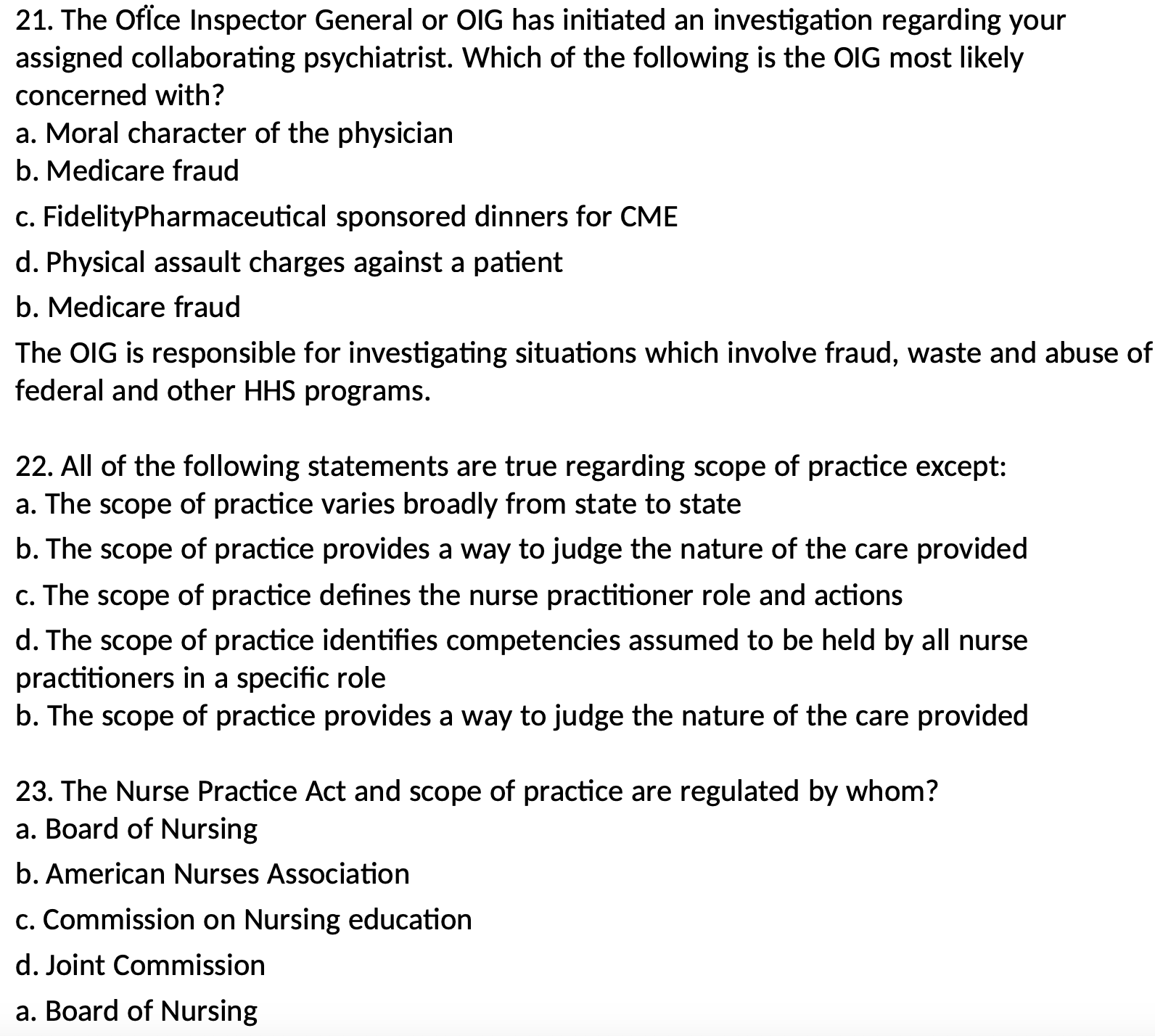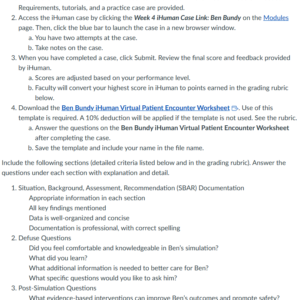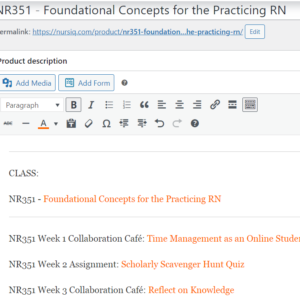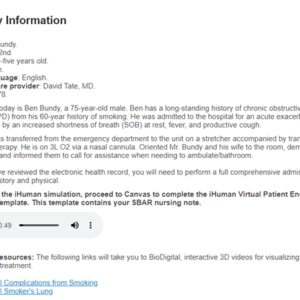[SOLVED] PMHNP Pre-Clinical Diagnostic Exam
1.Which of the following is characteristic of the leadership competency for APRNs?
a.Participating in a community-focused program that promotes mental health and
reduces the risk of mental health problems
b.Modifying the treatment plan based on the patient’s needs
c.Developing an age-appropriate treatment plan
d.Evaluating the appropriate use of seclusion
a.Participating in a community-focused program that promotes mental health and reduces the risk of mental health problems
2.Which of the following allows the PMHNP to practice in a state?
a.Graduation
b.Licensure
c.Credentialing
d.Certification
b.Licensure
3.A new graduate PMHNP is considering a job at a psychiatric ED. The medical director
informs the prospective hire that they are expected to evaluate and treat children,
adolescents, adults, and geriatric patients. What document should be consulted to
determine if the PMHNP can legally treat psychiatric patients across the life span?
a, The hospital bylaws
b.The PMHNP can treat any patient because there is a collaborating physician
c.The PMHNP scope of practice
d.The state Nurse Practice Act
d. The state Nurse Practice Act
4.The process of integrating the best research evidence with clinical expertise and client
needs and values is known as:
a.Evidence-based practice
b.Quality improvement
c.Research
d.Research utilization
a.Evidence-based practice
5.Morgan is an RN on a busy cerebrovascular accident unit at the local hospital. She
forgot to turn her patient every 2 hours in bed and now he has a stage I decubitus ulcer.
What could this be best described as?
a.Lack of consent
b.Violations order
c.Negligence
d.Battery
c.Negligence
6.All of the following are governed by the institutional review board except:
a.Ensuring equitable selection
b.Regulating funding for the study
c.Evaluating risks and benefits, ensuring reporting of adverse events
d.Ensuring risks to participants are minimized
b.Regulating funding for the study
7.Atith is a 21 year old male from Cambodia. His chest reveals long raised red marks
from dragging a coin across his skin. Recognizing this cultural concept would prompt the
PMHNP to consider what potential diagnosis within the DSM-5?
a.Agoraphobia
b.Panic disorder
c.PTSD
d.All of these diagnoses are possible.
d. All of these diagnoses are possible.
8.A cultural explanation of distress including fatigue, weakness, weight loss, somatic
complaints, depressed mood and impotence thought to be related to semen loss is
otherwise known as dhat in this region of the world. Where is a client most likely from
given the specific complaint of dhat?
a.Australia and Fiji
b.China and Southeast Asia
c.India and Pakistan
d.Russia and Ukraine
c.India and Pakistan
9.A 34-year-old Korean male pediatric dentist is referred to psychiatry for persistent
anxiety. Upon further assessment, he reveals that his penis is shrinking into his
abdomen. Despite the reassurance he has received from numerous health care
providers in the past he remains convinced of this belief. This culture-bound delusion is known as:
a.Zar
b.Taijin kyofusho
c.Koro
d.Kuru
c. Koro
10.All of the following are attributes of cultural care that may influence the therapeutic
alliance except?
a.Urban setÝng
b.Beliefs
c.Religion
d.Gender roles
a.Urban setÝng
11.Which statistical test differentiates among three or more groups?
a.T-test
b.Pearson’s r correlation
c.Probability
d.Analysis of variance (ANOVA)
d. Analysis of variance (ANOVA)
12.The level of significance describing the probability of a particular result occurring by
chance alone is represented by which of the following?
a.Odds ratio
b.p-value
c.Confidence interval
d.z-score
b.p-value
13.The PMHNP is working with an insurance organization to provide oversight and
authorization of series and benefits to patients. Which role of the PMHNP best
describes this activity?
a.Advocacy
b.Mentoring
c.Case management
d.Policy making
c.Case management
14.What method of analysis describes the basic features of the data and
summarizes and organizes observations?
a.Inferential statistics
b.Descriptive statistics
c.Regression analysis
d.Analysis of variance (ANOVA)
b. Descriptive statistics
15.Which statistical test identifies a relationship between two variables?
a.Pearson’s r correlation
b.Probability
c.Analysis of variance (ANOVA)
Downloaded by paul Sanganyi (sanganyipaul634@gmail.com)lOMoARcPSD|19565686
d.t-test
a.Pearson’s r correlation
16.The process of synthesizing, disseminating, and using research-generated
knowledge to make a change in practice is known as:
a.Research utilization
b.Research
c.Evidence-based practice
d.Quality improvement
a.Research utilization
17.The learned beliefs and behaviors common among all members of a group defines:
a.Folie a familie
b.Complex delusions
c.Culture
d.Folie a deux
c. Culture
18.During a psychiatric evaluation, the client reveals to the PMHNP a transgender identity.
The client indicates a preference for personal pronouns like he and him. What is the
biological sex of the client?
a.Female
b.Asexual
c.Male
d.Lesbian
a.Female
19.Andika, a 26 year old male from Indonesia swung a sword at a doctor shortly after
the sudden death of his father. He lost consciousness, collapsing to the floor after the
violent attempt to hurt the doctor. Which culture bound syndrome best describes
Andika’s behavior?
a.Latah
b.Amok
c.Ataque de nervios
d.Koro
b.Amok
20.Use the following scenario to answer question regarding the Health Belief Model
(HBM): A PMHNP is leading a recovery group for at-risk teens who have been mandated to
attend meetings as part of their addiction treatment. A member of the group expresses
how difÏcult it has been to maintain her sobriety and as a result does not feel she will be
successful this time. Which concept of the Health Belief Model would be the most
significant risk factor for relapse?
a.Perceived severity and perceived barriers
Downloaded by paul Sanganyi (sanganyipaul634@gmail.com)lOMoARcPSD|19565686
b.Cues to action and perceived severity
c.Self-efÏcacy and perceived susceptibility
d.Self-efÏcacy and perceived benefits
b. Cues to action and perceived severity……………………………purchase all the questions and their correct answers for $50 only





Reviews
There are no reviews yet.